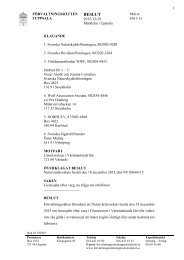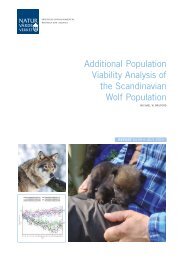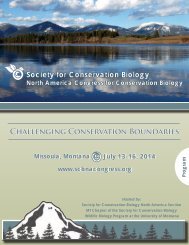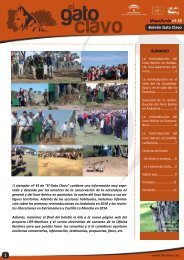1oC3Dbk
1oC3Dbk
1oC3Dbk
You also want an ePaper? Increase the reach of your titles
YUMPU automatically turns print PDFs into web optimized ePapers that Google loves.
During November, we signed the Python Conservation<br />
Partnership (PCP) with the luxury brand Kering (owner of<br />
Gucci) and the International Trade Centre (ITC). This is a threeyear<br />
initiative which aims to contribute to the improved<br />
sustainability of the python trade and help facilitate industrywide<br />
change. This partnership was the result of a year of<br />
conversations with our partners, and two meetings held in<br />
Florence (July) and Geneva (October), as well as different<br />
missions to visit CITES authorities in China, Indonesia,<br />
Malaysia and Vietnam.<br />
Thanks to the initiative of two BPSG members, the<br />
Inaugural Meeting of the Caribbean and Latin American Boid<br />
Group was held at the Universidad Interamericana de Puerto<br />
Rico in Arecibo during early August. As a result of this meeting,<br />
the membership of the BPSG will increase to about 90<br />
members and we expect to increase our capacity for future<br />
Red List assessments. Red List assessments continue under<br />
the monitoring of Mark Auliya, our RLA Coordinator. We<br />
continue compiling and editing our newsletter Serpens twice a<br />
year, and updating the BPSG’s Facebook page thanks to<br />
Jessica Lyons.<br />
We would like to acknowledge Fundación Biodiversidad<br />
– Argentina for providing us with an executive office and to the<br />
Office Vétérinaire Federal of Switzerland for funding our year<br />
running costs.<br />
Tomás Waller<br />
Chair, Boa and Python Specialist Group<br />
Brazil Plant Red List Authority<br />
During 2013, we concluded the assessment of 4,617 taxa (58<br />
of them are subspecies or varieties of plants). From this total,<br />
2,118 species were assessed as threatened and an official<br />
document was delivered to the Ministry of Environment. For<br />
The IUCN Red List, it is also relevant to mention that of these<br />
4,617 taxa, 3,341 are global assessments (i.e. endemics) and<br />
1,276 are national assessments (not endemics or unknown if<br />
endemic or not). Of the definite endemics, 1,816 are<br />
threatened. We are collaborating with the Ministry of<br />
Environment in order to improve and discuss some of the<br />
existing legal documents regarding flora conservation in Brazil.<br />
We have developed a system for flora extinction risk<br />
assessment and threatened species data compiling, where<br />
specialists can contribute online.<br />
We published the first Brazilian Flora Red Book. This is the<br />
first time that Brazil has used the IUCN system to rigorously<br />
assess plant species. We launched the CNCFlora website and<br />
Facebook page, and started using social media to improve<br />
communication with researchers and the public. Working as<br />
consultants, we assisted Brazilian states and other countries<br />
with the implementation of Red Listing processes and flora<br />
conservation strategies. We also organized scientific<br />
expeditions to remote places, which involved data gathering<br />
for many threatened species. Action plans continue to be<br />
developed for threatened species.<br />
Looking forward, we need to improve support among<br />
specialists and conservation organizations to assess the<br />
extremely high number of Brazilian species. The low budget<br />
and lack of consistent support from Brazilian authorities and<br />
global organizations prevents us from achieving this task. Laws<br />
protecting threatened species, especially the ones with<br />
economic value do exist, but are not always enforced, so this<br />
Alstroemeria caryophyllaea jacq. © Marco Octavio O. Pellegrini<br />
needs updating. To date, there are 43,788 plant species in our<br />
flora, and according to GSPC’s target 2; all species must be<br />
assessed, so we have a long way to go! We hope to raise the<br />
necessary funds to support more capacity building, research<br />
and conservation strategies. We also hope to increase<br />
collaboration between conservation organizations and the<br />
public. We continue the assessment of flora species; updating<br />
previously concluded assessments, planning conservation<br />
actions for all threatened species, as well as identifying priority<br />
areas for flora conservation in Brazil.<br />
Dr Gustavo Martinelli<br />
Brazil Plant Red List Authority Coordinator<br />
Bryophyte<br />
Specialist Group<br />
The mission and key<br />
objective of our Specialist<br />
Group has been to highlight<br />
the importance of<br />
recognising bryophytes in<br />
all areas of nature<br />
conservation. This is<br />
essential, since bryophytes<br />
(mosses, liverworts and<br />
Sorapilla papuana – a moss we<br />
suspected to be Extinct in<br />
Australia as it had not been seen<br />
for 150 years, but it was recently<br />
re-discovered in Queensland.<br />
© Bill Malcolm<br />
36 IUCN species Annual Report 2013






